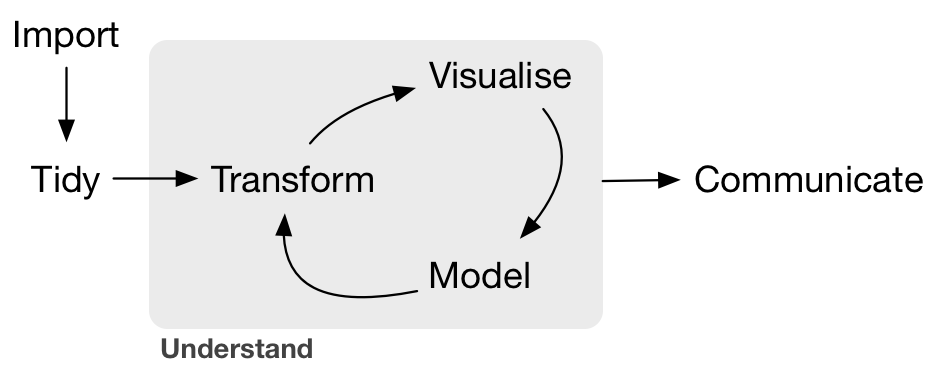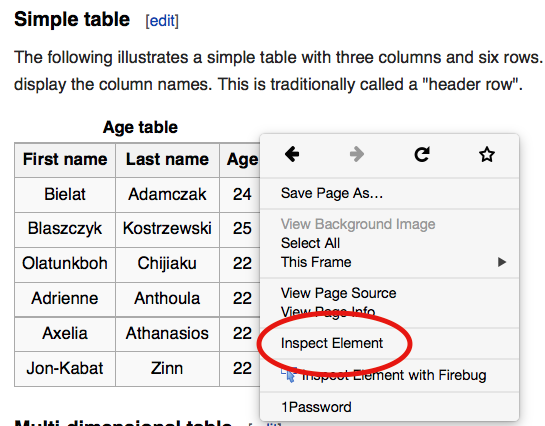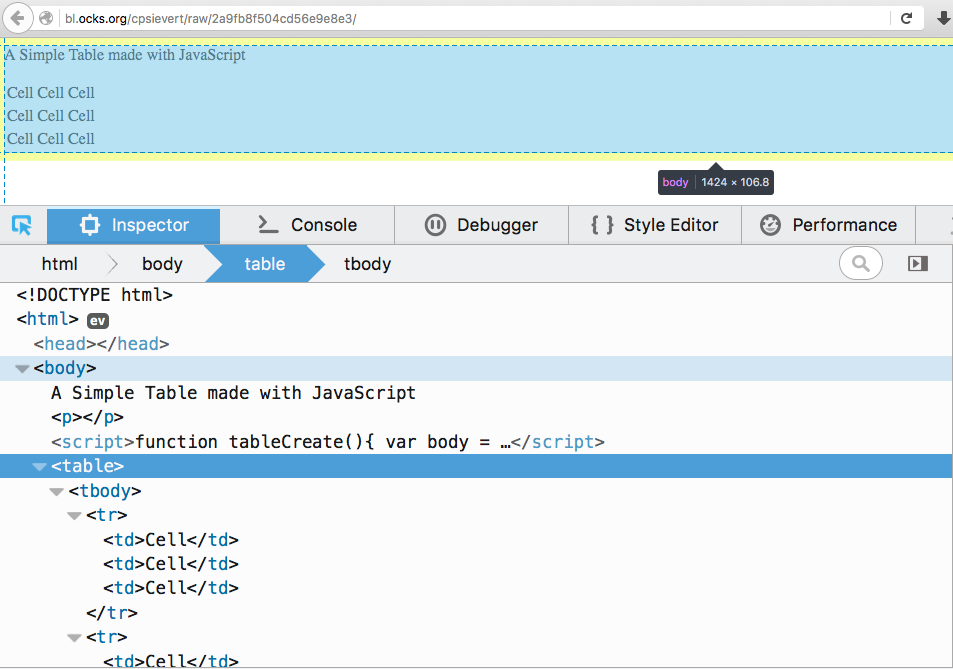---
title: "Web scraping and graphics"
subtitle: "E/EBS Honours, Monash University"
author: "Carson Sievert (cpsievert1@gmail.com, @cpsievert); Di Cook (dicook@monash.edu, @visnut); Heike Hofmann (heike.hofmann@gmail.com, @heike_hh) Barret Schloerke (schloerke@gmail.com, @schloerke)"
date: "`r Sys.Date()`"
output:
ioslides_presentation:
transition: default
widescreen: true
css:
styles.css
---
```{r, echo = FALSE}
knitr::opts_chunk$set(
message = FALSE,
warning = FALSE,
collapse = TRUE,
comment = "#>",
fig.height = 4,
fig.width = 8,
fig.align = "center",
cache = FALSE
)
```
## The Data Analysis Workflow

* Adapted from [R for data science](http://r4ds.had.co.nz/intro.html) by Garrett Grolemund and Hadley Wickham.
## A web of data
- In 2008, [an estimated](http://yz.mit.edu/papers/webtables-vldb08.pdf) __154 million HTML tables__ (out of the 14.1 billion) contain 'high quality relational data'!!!
- Hard to quantify how much more exists outside of HTML Tables, but there is [an estimate](https://cs.uwaterloo.ca/~x4chu/SIGMOD2015_1.pdf) of __at least 30 million lists__ with 'high quality relational data'.
- A growing number of websites/companies [provide programmatic access](http://www.programmableweb.com/category/all/apis?order=field_popularity) to their data/services via web APIs (that data typically comes in XML/JSON format).
## Before scraping, do some googling!
- Chances are, someone else built a tool to help you.
- I wrote [pitchRx](http://cran.r-project.org/web/packages/pitchRx/) which downloads, parses, cleans, and transforms XML data for a specific baseball data resource. Just give it start/end dates.
- [ropensci](https://ropensci.org/) has a [ton of R packages](https://ropensci.org/packages/) providing easy-to-use interfaces to open data.
- The [Web Technologies and Services CRAN Task View](http://cran.r-project.org/web/views/WebTechnologies.html) is a great overview of various tools for working with data that lives on the web in R.
## A web of _messy_ data!
- In statistical modeling, we typically assume data is [tidy](http://vita.had.co.nz/papers/tidy-data.pdf).
- That is, data appears in a tabular form where
* 1 row == 1 observation
* 1 column == 1 variable (observational attribute)
- Parsing HTML/XML/JSON is easy; but putting it into a tidy form is typically _not easy_.
- Knowing a bit about modern tools & web technologies makes it _much_ easier.
## Motivating Example
## Inspecting elements

## Hover to find desired elements

## Wikitable
```{r}
library(rvest)
src <- html("http://en.wikipedia.org/wiki/Table_(information)")
node <- html_node(src, css = ".wikitable")
```
- `".wikitable"` is a CSS selector which says: "grab nodes (aka elements) with a class of wikitable".
- `html_table()` converts a single `` node to a data frame.
```{r}
html_table(node)
```
## Pipeable!
```{r}
html("http://en.wikipedia.org/wiki/Table_(information)") %>%
html_node(".wikitable") %>% html_table()
```
- Much easier to read/understand!
## Your Turn 1
Navigate [this page](http://www.wunderground.com/history/airport/KVAY/2015/2/17/DailyHistory.html?req_city=Cherry+Hill&req_state=NJ&req_statename=New+Jersey&reqdb.zip=08002&reqdb.magic=1&reqdb.wmo=99999&MR=1) and try the following:
__Easy__: Grab the table at the bottom of the page (hint: instead of grabbing a node by class with `html_node(".class")`, you can grab by id with `html_node("#id")`)
__Medium__: Grab the actual mean, max, and min temperature.
__Hard__: Grab the weather history graph and write the figure to disk (`download.file()` may be helpful here).
[See here](https://gist.github.com/cpsievert/57be009120bb5298affa) for a solution (thanks Hadley Wickham for the example)
# What about non-`` data?
## (selectorgadget + rvest) to the rescue!
- [Selectorgadget](http://selectorgadget.com/) is a [Chrome browser extension](https://chrome.google.com/webstore/detail/selectorgadget/mhjhnkcfbdhnjickkkdbjoemdmbfginb?hl=en) for quickly extracting desired parts of an HTML page.
- With some user feedback, the gadget find out the [CSS selector](http://www.w3.org/TR/2011/REC-css3-selectors-20110929/) that returns the highlighted page elements.
- Let's try it out on [this page](http://www.sec.gov/litigation/suspensions.shtml)
## Extracting links to download reports
```{r}
domain <- "http://www.sec.gov"
susp <- paste0(domain, "/litigation/suspensions.shtml")
hrefs <- html(susp) %>% html_nodes("p+ table a") %>% html_attr(name = "href")
tail(hrefs)
```
```{r, eval = FALSE}
# download all the pdfs!
hrefs <- hrefs[!is.na(hrefs)]
pdfs <- paste0(domain, hrefs)
mapply(download.file, pdfs, basename(pdfs))
```
## Your Turn 2
Nativigate to Wikipedia's [list of data structures](http://en.wikipedia.org/wiki/List_of_data_structures) use SelectorGadget + rvest to do the following:
1. Obtain a list of Primitive types
2. Obtain a list of the different Array types
[See here](https://gist.github.com/cpsievert/c1b851ff5e1bd846de46) for a solution.
# Scraping _dynamic_ web pages
## A simple example

---
```{r, error = TRUE}
html("http://bl.ocks.org/cpsievert/raw/2a9fb8f504cd56e9e8e3/") %>%
html_node("table")
```
* Huh, no ``?
---
```{r}
html("http://bl.ocks.org/cpsievert/raw/2a9fb8f504cd56e9e8e3/") %>%
html_node("body") %>% as.character() %>% cat()
```
## Browser <-> Web Server
---
[rdom](https://github.com/cpsievert/rdom) can construct the DOM:
```{r, eval = FALSE}
library(rdom)
rdom("http://bl.ocks.org/cpsievert/raw/2a9fb8f504cd56e9e8e3/") %>%
html_node("table") %>% html_table()
```
```
X1 X2 X3
1 Cell Cell Cell
2 Cell Cell Cell
3 Cell Cell Cell
```
You can give `rdom()` CSS Selectors directly to avoid sending the _entire_ DOM from phantomjs to R
```{r, eval = FALSE}
rdom("http://www.techstars.com/companies/stats/", "table") %>%
html_table()
```
## Don't abuse your power
- If you scrape a website, please read the terms and conditions!!
- For [client-side dynamic sites](https://en.wikipedia.org/wiki/Dynamic_web_page#Client-side_scripting), it's sometimes more efficient/appropriate to [find the API](http://www.gregreda.com/2015/02/15/web-scraping-finding-the-api/) rather than rendering the entire DOM.
- If a website public offers an API, USE IT (instead of scraping)!!!
## Web APIs
- [Server-side Web APIs](https://en.wikipedia.org/wiki/Web_API#Server-side) are a popular way to provide easy access to data and other services.
- If you (the client) want data from a server, you typically need one HTTP verb -- `GET`.
```{r}
library(httr)
response <- GET("https://api.github.com/users/hadley")
content(response)[c("name", "company")]
```
- Other HTTP verbs -- `POST`, `PUT`, `DELETE`, etc...
* You probably won't need these unless your developing a web app.
## Request/response model
- When you (the client) _requests_ a resource from the server. The server _responds_ with a bunch of additional information.
```{r}
response$header[1:3]
```
- Nowadays content-type is usually XML or JSON (HTML is great for _sharing content_ between _people_, but it isn't great for _exchanging data_ between _machines_.)
## What is XML?
XML is a markup language that looks very similar to HTML.
```xml
Wario Bike
Piranha Prowler
Royal Racer
Wild Wing
```
- This example shows that XML can (and is) used to store inherently tabular data ([thanks Jeroen Ooms for the fun example](http://arxiv.org/pdf/1403.2805v1.pdf))
- What is are the observational units here? How many observations in total?
- Two units and 6 total observations (4 vehicles and 2 drivers).
## XML2R
[XML2R](https://github.com/cpsievert/XML2R) is a framework to simplify acquistion of tabular/relational XML.
```{r, eval = FALSE}
library(XML2R)
obs <- XML2Obs("https://gist.githubusercontent.com/cpsievert/85e340814cb855a60dc4/raw/651b7626e34751c7485cff2d7ea3ea66413609b8/mariokart.xml")
table(names(obs))
```
```{r, echo = FALSE}
library(XML2R)
obs <- XML2Obs("https://gist.githubusercontent.com/cpsievert/85e340814cb855a60dc4/raw/651b7626e34751c7485cff2d7ea3ea66413609b8/mariokart.xml", quiet = TRUE)
obs <- lapply(obs, function(x) x[, !colnames(x) %in% "url", drop = FALSE])
table(names(obs))
```
* The main idea of __XML2R__ is to coerce XML into a _flat_ list of observations.
* The list names track the "observational unit".
* The list values track the "observational attributes".
---
```{r}
obs
```
---
```{r}
collapse_obs(obs) # group into table(s) by observational name/unit
```
- What information have I lost?
- I can't map vehicles to the drivers!
---
```{r}
obs <- add_key(obs, parent = "mariokart//driver", recycle = "name")
collapse_obs(obs)
```
---
Now (if I want) I can merge the tables into a single table...
```{r}
tabs <- collapse_obs(obs)
merge(tabs[[1]], tabs[[2]], by = "name")
```
## What about JSON?
- JSON is quickly becoming _the_ format for data on the web.
- JavaScript Object Notation (JSON) is comprised of two components:
* arrays => [value1, value2]
* objects => {"key1": value1, "key2": [value2, value3]}
## Back to Mariokart {.smaller}
```json
[
{
"driver": "Bowser",
"occupation": "Koopa",
"vehicles": [
{
"model": "Wario Bike",
"speed": 55,
"weight": 25
},
{
"model": "Piranha Prowler",
"speed": 40,
"weight": 67
}
]
},
{
"driver": "Peach",
"occupation": "Princess",
"vehicles": [
{
"model": "Royal Racer",
"speed": 54,
"weight": 29
},
{
"model": "Wild Wing",
"speed": 50,
"weight": 34
}
]
}
]
```
---
```{r}
library(jsonlite)
mario <- fromJSON("http://bit.ly/mario-json")
str(mario) # nested data.frames?!?
```
---
```{r}
mario$driver
mario$vehicles
```
How do we get two tables (with a common id) like the XML example?
---
```{r}
# this mapply statement is essentially equivalent to add_key
vehicles <- Map(function(x, y) cbind(x, driver = y),
mario$vehicles, mario$driver)
Reduce(rbind, vehicles)
mario[!grepl("vehicle", names(mario))]
```
# Hello shiny!
## What is shiny?
* *courtesy of :
## Motivating Example
```{r, eval = FALSE}
# install dependencies and run first example (press ESC to quit)
if (!require("shiny")) install.packages("shiny")
if (!require("leaflet")) install.packages("leaflet")
runGitHub("rstudio/shiny-examples", subdir = "063-superzip-example")
```
## Learn by example
```{r, eval = FALSE}
library(shiny)
library(ggplot2)
ui <- fluidPage(
numericInput(
inputId = "size",
label = "Choose a point size",
value = 3, min = 1, max = 10
),
plotOutput("plotId")
)
server <- function(input, output) {
output$plotId <- renderPlot({
ggplot(mtcars, aes(wt, mpg)) +
geom_point(size = input$size)
})
}
shinyApp(ui, server)
```
---
```{r, eval = FALSE}
ui <- fluidPage(
sidebarPanel(
selectInput(
inputId = "x", label = "Choose an x variable", choices = names(mtcars)
),
selectInput(
inputId = "y", label = "Choose an y variable", choices = names(mtcars)
)
),
mainPanel(
plotOutput("plotId")
)
)
server <- function(input, output) {
output$plotId <- renderPlot({
ggplot(mtcars, aes_string(input$x, input$y)) +
geom_point()
})
}
shinyApp(ui, server)
```
## Your Turn
* Add a control for `colour`.
* Get creative!



